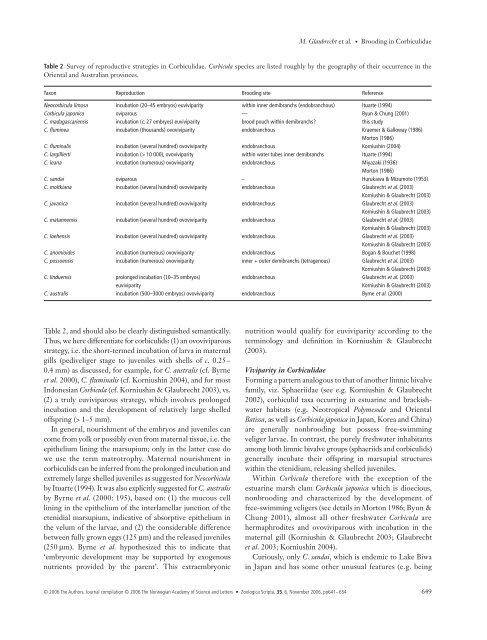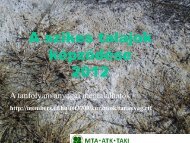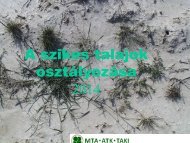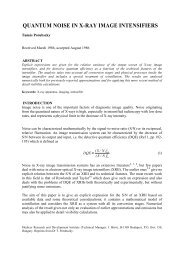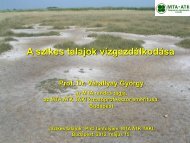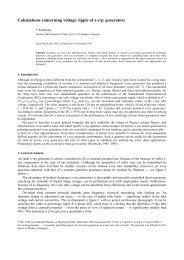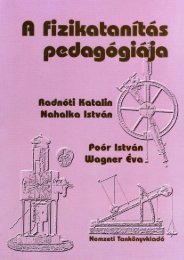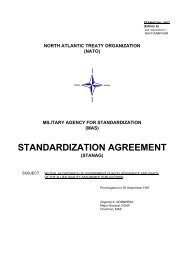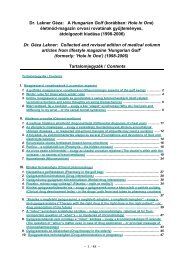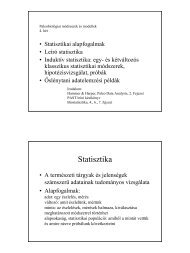Brooding in Corbicula madagascariensis (Bivalvia, Corbiculidae)
Brooding in Corbicula madagascariensis (Bivalvia, Corbiculidae)
Brooding in Corbicula madagascariensis (Bivalvia, Corbiculidae)
- No tags were found...
You also want an ePaper? Increase the reach of your titles
YUMPU automatically turns print PDFs into web optimized ePapers that Google loves.
M. Glaubrecht et al. • <strong>Brood<strong>in</strong>g</strong> <strong>in</strong> <strong>Corbiculidae</strong>Table 2 Survey of reproductive strategies <strong>in</strong> <strong>Corbiculidae</strong>. <strong>Corbicula</strong> species are listed roughly by the geography of their occurrence <strong>in</strong> theOriental and Australian prov<strong>in</strong>ces.Taxon Reproduction <strong>Brood<strong>in</strong>g</strong> site ReferenceNeocorbicula limosa <strong>in</strong>cubation (20–45 embryos) euviviparity with<strong>in</strong> <strong>in</strong>ner demibranchs (endobranchous) Ituarte (1994)<strong>Corbicula</strong> japonica oviparous — Byun & Chung (2001)C. <strong>madagascariensis</strong> <strong>in</strong>cubation (c. 27 embryos) euviviparity brood pouch with<strong>in</strong> demibranchs? this studyC. flum<strong>in</strong>ea <strong>in</strong>cubation (thousands) ovoviviparity endobranchous Kraemer & Galloway (1986)Morton (1986)C. flum<strong>in</strong>alis <strong>in</strong>cubation (several hundred) ovoviviparity endobranchous Korniush<strong>in</strong> (2004)C. largillierti <strong>in</strong>cubation (> 10 000), ovoviviparity with<strong>in</strong> water tubes <strong>in</strong>ner demibranchs Ituarte (1994)C. leana <strong>in</strong>cubation (numerous) ovoviviparity endobranchous Miyazaki (1936)Morton (1986)C. sandai oviparous – Hurukawa & Mizumoto (1953)C. moltkiana <strong>in</strong>cubation (several hundred) ovoviviparity endobranchous Glaubrecht et al. (2003)Korniush<strong>in</strong> & Glaubrecht (2003)C. javanica <strong>in</strong>cubation (several hundred) ovoviviparity endobranchous Glaubrecht et al. (2003)Korniush<strong>in</strong> & Glaubrecht (2003)C. matannensis <strong>in</strong>cubation (several hundred) ovoviviparity endobranchous Glaubrecht et al. (2003)Korniush<strong>in</strong> & Glaubrecht (2003)C. loehensis <strong>in</strong>cubation (several hundred) ovoviviparity endobranchous Glaubrecht et al. (2003)Korniush<strong>in</strong> & Glaubrecht (2003)C. anomioides <strong>in</strong>cubation (numerous) ovoviviparity endobranchous Bogan & Bouchet (1998)C. possoensis <strong>in</strong>cubation (numerous) ovoviviparity <strong>in</strong>ner + outer demibranchs (tetragenous) Glaubrecht et al. (2003)Korniush<strong>in</strong> & Glaubrecht (2003)C. l<strong>in</strong>duensis prolonged <strong>in</strong>cubation (10–35 embryos) endobranchous Glaubrecht et al. (2003)euviviparity Korniush<strong>in</strong> & Glaubrecht (2003)C. australis <strong>in</strong>cubation (500–3000 embryos) ovoviviparity endobranchous Byrne et al. (2000)Table 2, and should also be clearly dist<strong>in</strong>guished semantically.Thus, we here differentiate for corbiculids: (1) an ovoviviparousstrategy, i.e. the short-termed <strong>in</strong>cubation of larva <strong>in</strong> maternalgills (pediveliger stage to juveniles with shells of c. 0.25–0.4 mm) as discussed, for example, for C. australis (cf. Byrneet al. 2000), C. flum<strong>in</strong>alis (cf. Korniush<strong>in</strong> 2004), and for mostIndonesian <strong>Corbicula</strong> (cf. Korniush<strong>in</strong> & Glaubrecht 2003), vs.(2) a truly euviviparous strategy, which <strong>in</strong>volves prolonged<strong>in</strong>cubation and the development of relatively large shelledoffspr<strong>in</strong>g (> 1–5 mm).In general, nourishment of the embryos and juveniles cancome from yolk or possibly even from maternal tissue, i.e. theepithelium l<strong>in</strong><strong>in</strong>g the marsupium; only <strong>in</strong> the latter case dowe use the term matrotrophy. Maternal nourishment <strong>in</strong>corbiculids can be <strong>in</strong>ferred from the prolonged <strong>in</strong>cubation andextremely large shelled juveniles as suggested for Neocorbiculaby Ituarte (1994). It was also explicitly suggested for C. australisby Byrne et al. (2000: 195), based on: (1) the mucous celll<strong>in</strong><strong>in</strong>g <strong>in</strong> the epithelium of the <strong>in</strong>terlamellar junction of thectenidial marsupium, <strong>in</strong>dicative of absorptive epithelium <strong>in</strong>the velum of the larvae, and (2) the considerable differencebetween fully grown eggs (125 µm) and the released juveniles(250 µm). Byrne et al. hypothesized this to <strong>in</strong>dicate that‘embryonic development may be supported by exogenousnutrients provided by the parent’. This extraembryonicnutrition would qualify for euviviparity accord<strong>in</strong>g to theterm<strong>in</strong>ology and def<strong>in</strong>ition <strong>in</strong> Korniush<strong>in</strong> & Glaubrecht(2003).Viviparity <strong>in</strong> <strong>Corbiculidae</strong>Form<strong>in</strong>g a pattern analogous to that of another limnic bivalvefamily, viz. Sphaeriidae (see e.g. Korniush<strong>in</strong> & Glaubrecht2002), corbiculid taxa occurr<strong>in</strong>g <strong>in</strong> estuar<strong>in</strong>e and brackishwaterhabitats (e.g. Neotropical Polymesoda and OrientalBatissa, as well as <strong>Corbicula</strong> japonica <strong>in</strong> Japan, Korea and Ch<strong>in</strong>a)are generally nonbrood<strong>in</strong>g but possess free-swimm<strong>in</strong>gveliger larvae. In contrast, the purely freshwater <strong>in</strong>habitantsamong both limnic bivalve groups (sphaeriids and corbiculids)generally <strong>in</strong>cubate their offspr<strong>in</strong>g <strong>in</strong> marsupial structureswith<strong>in</strong> the ctenidium, releas<strong>in</strong>g shelled juveniles.With<strong>in</strong> <strong>Corbicula</strong> therefore with the exception of theestuar<strong>in</strong>e marsh clam <strong>Corbicula</strong> japonica which is dioecious,nonbrood<strong>in</strong>g and characterized by the development offree-swimm<strong>in</strong>g veligers (see details <strong>in</strong> Morton 1986; Byun &Chung 2001), almost all other freshwater <strong>Corbicula</strong> arehermaphrodites and ovoviviparous with <strong>in</strong>cubation <strong>in</strong> thematernal gill (Korniush<strong>in</strong> & Glaubrecht 2003; Glaubrechtet al. 2003; Korniush<strong>in</strong> 2004).Curiously, only C. sandai, which is endemic to Lake Biwa<strong>in</strong> Japan and has some other unusual features (e.g. be<strong>in</strong>g© 2006 The Authors. Journal compilation © 2006 The Norwegian Academy of Science and Letters • Zoologica Scripta, 35, 6, November 2006, pp641–654 649


